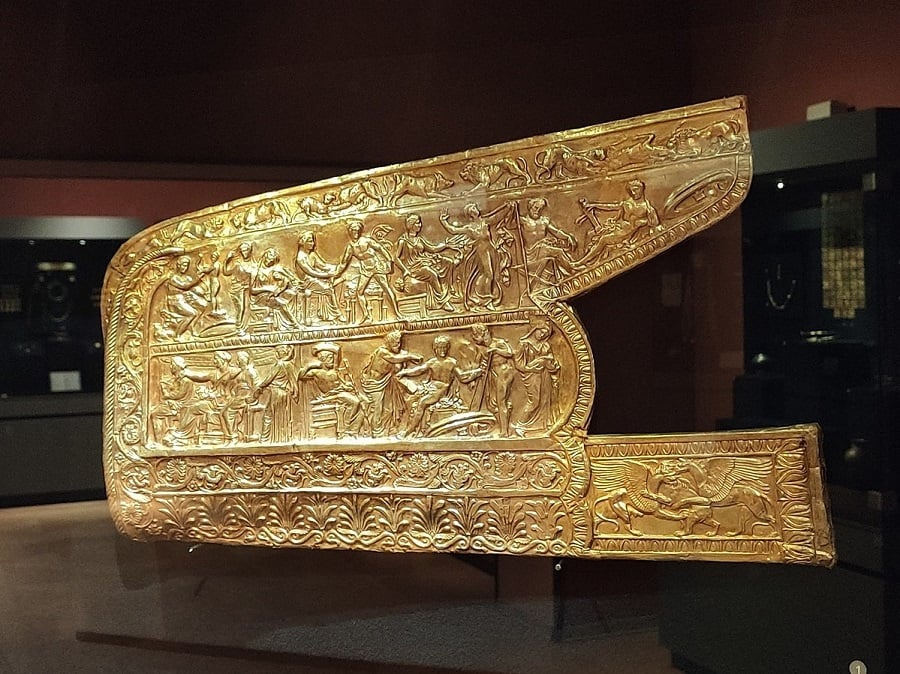
Officials in Ukraine say that Russia has looted a number of museums and has removed valuable exhibits, including ancient Greek gold artifacts given by the Greeks to the Scythians.
The Scythians were a nomadic people that founded a rich, powerful empire centered in the Crimean Peninsula; the empire endured from around the eighth century B.C. to the second century A.D.
“Russia has taken hold of our Scythian gold,” declared Melitopol’s mayor, Ivan Fyodorov. “This is one of the largest and most expensive collections in Ukraine, and today we don’t know where they took it.”
The Melitopol Museum of Local History is home to 50,000 exhibits, but its prized collection was a set of rare gold ornaments from the Scythians.
Looted artifacts had been given to the Scythians by the Ancient Greeks
According to Leila Ibrahimova, the director of the Museum who spoke to the New York Times from a safe location away from the occupied city, Russian soldiers arrived at the museum and removed at least 198 gold items, including ornaments in the form of flowers; gold plates; rare, old weapons; 300-year-old silver coins; and special medals.
She said many of the gold artifacts had been given to the Scythians by the Greeks.
“Maybe culture is the enemy for them,” she told the New York Times. “They said that Ukraine has no state, no history. They just want to destroy our country. I hope they will not succeed.”
Russia “destroys” Ukraine’s cultural heritage
In Ukraine’s Mariupol, the town that has been hammered for weeks by Russia’s forces, officials said that Russian agents broke into an art museum and stole masterpiece paintings, a famous sculpture, and several highly valued Christian icons, including an 1811 Gospel created by the Venetian printing house for the Greeks of Mariupol.
Across Ukraine, officials said, dozens of Orthodox churches, national monuments, and cultural heritage sites have been destroyed by Russia’s forces. On Saturday, Ukrainian officials said that more than 250 cultural institutions had been damaged or destroyed.
Athens condemns the looting of ancient Greek artifacts by Russia
Greek Minister of Culture, Lina Mendoni, condemned the alleged looting of the museum in Ukraine by Russia. In a press release on Monday, she said it is “painful to watch the heinous looting of Scythian artifacts” from the Melitopolis Museum.
Mendoni said that it is not the first time that Russia has treated works of art in this way. He maintains that “Decades after the fall of the Nazi regime, Priam’s treasure trove from the Schliemann excavations was transported to Russia to be unveiled many years later, in 1993, at the Pushkin Museum. We unequivocally condemn these actions.”
She called for “urgent” measures to protect the cultural heritage of Ukraine, namely the creation of a Red List to prevent their illegal trafficking, the establishment of a platform for gathering information on looting and theft of cultural property, as well as the initiation of ad hoc legal and institutional measures to protect Ukraine’s cultural heritage.
Who were the Scythians
The Scythians played an important part in the operation of the Silk Road, the vast trade network connecting Greece, Persia, India and China, which most likely contributed to the prosperity of those civilizations.
Incredibly highly-skilled metalworkers created portable, decorative objects for the rulers, forming the glorious history of Scythian metalworking. These objects constituted an extremely distinctive type of Scythian art.
The name of the ancient Scythian peoples survives in the region known as Scythia. Early authors used the word Scythian for many groups who were actually unrelated to the original Scythians, including Huns, Goths, Turkic peoples, Avars, Khazars, and other unnamed nomads.
Although the Greek historian Herodotus refers to Scythian “kings,” even using their names at times, like most tribal peoples, Scythian rule was actually comprised of a confederation of tribes and chiefs.
Herodotus states that while a king or chief represented the Scythian nation in dealings with other peoples, subchiefs would also have a significant say in affairs.
Related: Magnificent Golden Comb Made by Greek Master a Highlight of Hermitage
See all the latest news from Greece and the world at Greekreporter.com. Contact our newsroom to report an update or send your story, photos and videos. Follow GR on Google News and subscribe here to our daily email!



